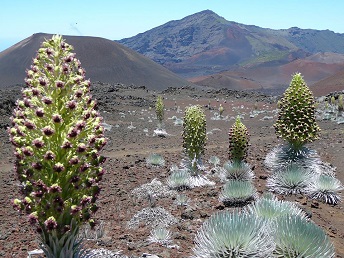Last updated: March 11, 2018
Lesson Plan
Protect Our Parks

- Grade Level:
- Upper Elementary: Third Grade through Fifth Grade
- Subject:
- Science
- Lesson Duration:
- 60 Minutes
- State Standards:
- Hawai‘i Content and Performance Standards III:
SC.3.7.4 - Additional Standards:
- Next Generation Science Standards:
SC.3.7.4
Objective
At the end of this lesson, the students will be able to determine how Haleakalā National Park protects cultural and natural resources and how the students can help protect them too.
Background
All organisms have a limited ability to adapt to drastic changes in their environment. If these changes occur slowly, then there is a higher probability a species can adapt to the changes. Too often the changes and impacts on our natural environments occur rather suddenly making it very hard for species to be able to adapt in time and survive. There are many small things that we as citizens can do to help care for our natural environments. When many of these small positive things are collectively done by many people they can have a big impact on the environment. Haleakalā National Parks purpose and mission is to protect and preserve the unique native habitats of Maui’s specially adapted native species. They need every one of us to help them to be successful in this mission.
Preparation
None.
Lesson Hook/Preview
Students think of ways to have a positive influence on the environment.
Procedure
Step 1: Review impacts on ecosystems
As a class discuss the effects that environmental impacts can have on an ecosystem. Some examples of adverse effects are: pollution, pesticides, global warming, climate change, fire, flood, litter, and depletion of resources.If these impacts change a habitat, how might plants or animals survive?
How might their different adaptations help them survive?
Step 2: Reflect on Haleakalā National Park Field Trip
Have students remind you of some of the native species that adapted to survive in Haleakalā National Park. Generate a list of how Haleakalā National Park helps to protect these special native species.- Stay on the trail rule
- Cattle fences
- Relocating 4-legged animals
- Planting native plants
- Educating people
Step 3: Journal Activity
Encourage a class discussion about our responsibility or kuleana to protect the environment. Have students write in their journals the answers to the following questions:- How can we take better care of habitats and the environment?
- How can we take better care of our parks in Maui?
- Why should people try to protect our parks?
- How does Haleakalā National Park care for the environment?
- Does Haleakalā National Park do a good job at protecting the environment? Explain your answer.
Step 4: Discuss and make a list on the board
Discuss as a class and list on the board ways they can help protect the environment at the park, at home, or at school. These are some ideas:- Respecting all living creatures
- Telling friends to respect creatures
- Picking up litter
- Brush boots
- Sharing with others about Maui’s specially adapted native plants and animals and fragile native habitats
- Staying on trail
- Reduce, Reuse, Recycle
- Leave no trace
- Eat locally grown foods
- Conserve water
- Conserve electricity
- Water plants
- Grow a garden
- Carry a reusable water bottle
- Use reusable bags for shopping
- Take reusable lunch containers
- Leave places better than you found them
Step 5: Action
Conclude with a positive message: caring citizens can make a positive difference in our world! So, let’s do something that will help our school community or our local community protect the environment.What are some things we could do to help educate our school or local community? Make a list of their ideas, and focus them to something that is reasonable to implement. Action ideas:
- Create a brochure that communicates to other students how to “Protect our Parks”. Then, distribute to other grades, along with a small presentation to each class by the students.
- Create a giant “Mālama Aina” (care for the land) poster display in the hall to share with other students the many ways we can help care for the environment.
Vocabulary
Ecosystem: A complex set of relationships among the living resources, habitats, and residents of an area.
Kuleana: Responsibility, being accountable to somebody or for something.
Pollution: Undesirable state of the natural environment being contaminated with harmful substances as a consequence of human activities.
Protect: Keep safe from harm.
